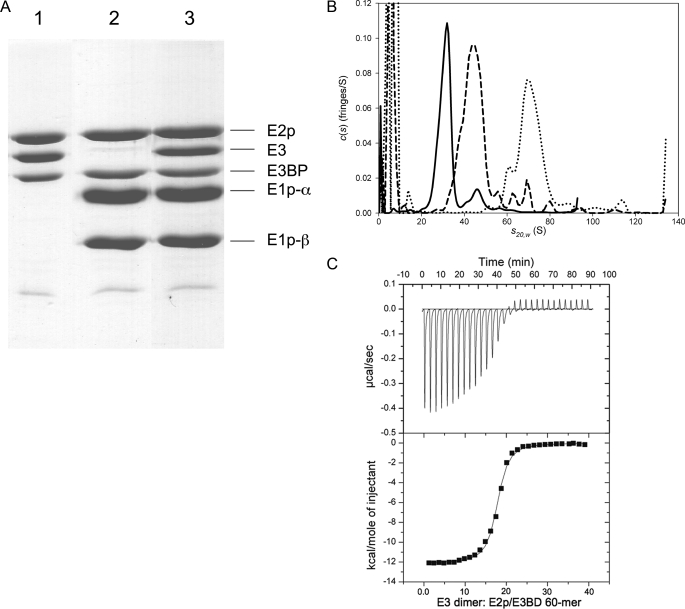FIGURE 1.
Subunit and catalytic component stoichiometries and solution behavior of an in vitro reconstituted PDC. A, in vitro assembly of the human pyruvate dehydrogenase complex. The E2p/E3BP core (0.45 nmol) in a potassium phosphate buffer, pH 7.5, was mixed with E3 (17.5 nmol) in a final volume of 2.6 ml (lane 1); the same sample of E2p/E3BP core was mixed with E1p (32 nmol) (lane 2); or the same E2p/E3BP core sample was mixed with E3 (17.5 nmol) and E1p (32 nmol) (lane 3). The protein mixtures were passed through a Sephacryl S-400 column to remove the excess unbound E3 or E1p. The stoichiometries of protein subunits were estimated by both Coomassie Blue staining intensity directly and by comparing to the standard curves obtained with individual protein standards. The subunit stoichiometry of E2p:E3BP in the 60-meric E2p/E3BP core is 40:20. The molar ratio of E2p/E3BP 60-mer:E1p heterotetramer:E3 dimer in the reconstituted PDC is 1:37:18 based on the staining intensity method normalized for the E1β subunit by comparison with the standard curve for this subunit. B, SV studies on PDC and its complexes with E3 and E1p. The solid line shows the c(s) distribution of PDC core alone, and the dashed line shows the distribution when a saturating concentration of E3 is added, and the dotted line shows the distribution when a saturating concentration of E1p is added. The large peaks on the left side of the distributions are because of excess E3 or E1p. C, ITC measurements of E3 binding to the reconstituted PDC core. The top panel is the thermogram that results from titrating the E3 dimer into a solution of E2p/E3BP. The solid varying line depicts enthalpy changes, and the flat line is the base line, as calculated by ORIGIN 7.0. The squares in the bottom panel are the integrated heats from each injection as derived from the data in the top panel, and the solid line is the fit to these data using a model that considers only a single type of binding sites. The molar ratio for E3 dimer:E2p/E3BP core is 18.8:1, based on the 40/20 E2p/E3BP model.

